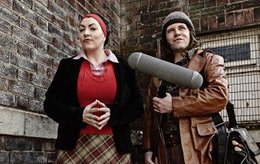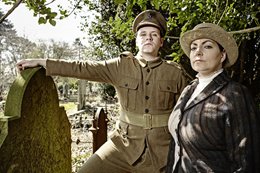In his first utterances, the tour guide correctly indicated that it is a difficult task to sum up eight hundred years of Irish history. Nevertheless, over the course of three and a half long hours of walking, he does his best to do so. He’s not an actor in a role, but a former member of the IRA and an ex-political prisoner who brings the tour group/audience to various sites of note along the Falls Road in West Belfast. As he speaks, it becomes evident that his version of history is a narrow one, and that his own personal experiences have shaped his view of the past. However, throughout the tour, his perspective is complicated somewhat by five short dramatic performances given by two wonderful actors playing various roles.
The first performance questions the role of the media in shaping our understanding of the conflict in Northern Ireland. The guide had already presented an historical context for the action, noting the significance in local history of the desolate and eerie St Comgall’s school. Strategically positioned, we were told that the old school was integral to defending the Falls from attack and our attention was drawn to the bullet holes eating into the bricks. The arrival of aspiring television reporter Laura (Antoinette Morelli) and cameraman Seamus (Gerard Jordan), both dressed in clothes from the 1970s, is humorous and insightful. Seamus’s flippant comment about a few locals “taking a pop” at newly arrived British Army troops is transformed and  embellished by Laura’s “media speak”. What he sees as a commonplace occurrence is dramatically altered by the media-savvy Laura who knows how to sell a story, altering her accent so that viewers outside of Northern Ireland can understand. Although poking fun at news reporters in Northern Ireland and suggesting that broadcasters simply look for dramatic news items that will sell, the piece also suggests that once the local accent is removed from the story, events can take on a life of their own.
embellished by Laura’s “media speak”. What he sees as a commonplace occurrence is dramatically altered by the media-savvy Laura who knows how to sell a story, altering her accent so that viewers outside of Northern Ireland can understand. Although poking fun at news reporters in Northern Ireland and suggesting that broadcasters simply look for dramatic news items that will sell, the piece also suggests that once the local accent is removed from the story, events can take on a life of their own.
When Morelli and Jordan later appear in costumes from the early 20th century, it becomes apparent that The West Awakes does not only question the manner in which events are reported, but also whose history is reported. Morelli is excellent as the passionate Biddy who wrestles with the knowledge that she is at the mercy of her male boss. As mill-worker Biddy pleads with Billy to forge documents for her child, the exploitation of many working women and children in Irish history is brought to the fore.
Continuing the walk down the Falls, an oft-forgotten aspect of the history of the Irish language is explored during a performance inside the doors of Culturlann McAdam O’Fiach, a building which was formerly a Presbyterian Church and is now an Irish-language centre. Based around a story of a couple who once attended Church here, the drama highlights the fact that Roibeard McAdam, a Presbyterian businessman, pioneered the revival of the Irish language in 19th Century Belfast. When Jordan, as the cantankerous Presbyterian Roy, refers to Irish as ‘our’ language, he points towards a shared cultural history rather than a divisive past. Although slightly difficult to follow at times, the piece asks the audience to consider how ideas surrounding the Irish language have been distorted and manipulated by rival sectarian groups.
 As the tour progresses, it is evident that the walk has taken its toll on the group and numbers begin to dwindle. The guide overloads the group with information and by the time the final two performances occur in the City Cemetery and Milltown Cemetery, it is difficult to sustain interest. In these pieces, Morelli and Jordan’s characters debate the ideals of James Connolly, the carnage that would follow in a divided Ireland, and the rights of workers. Both actors are good in their respective roles, although Jordan’s Kerry accent is sometimes unconvincing.
As the tour progresses, it is evident that the walk has taken its toll on the group and numbers begin to dwindle. The guide overloads the group with information and by the time the final two performances occur in the City Cemetery and Milltown Cemetery, it is difficult to sustain interest. In these pieces, Morelli and Jordan’s characters debate the ideals of James Connolly, the carnage that would follow in a divided Ireland, and the rights of workers. Both actors are good in their respective roles, although Jordan’s Kerry accent is sometimes unconvincing.
While the performances are enjoyable, their mode of questioning perspectives of history is in stark contrast to the simplistic accounts of the past which dominate the afternoon event. The main problem with The West Awakes is not the prolonged walk but with the guide’s selective version of history and his lack self-reflexivity, particularly when he attempts to justify his shooting of another person. It may be argued that the tour is an opportunity to offer a perspective of history from a community that was often marginalised or ignored by media and governments, but such tours also insulate and isolate the community and may perhaps even reinforce sectarianism.
Pádraic Whyte is a Visiting Research Fellow at the Institute of Irish Studies, Queen’s University Belfast.